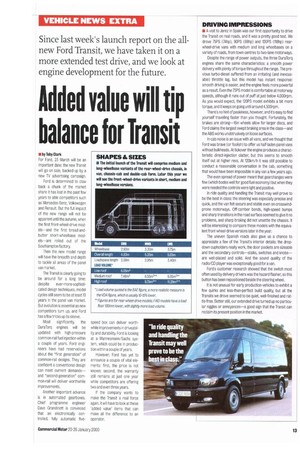DRIVING IMPRESSIONS
Page 15

If you've noticed an error in this article please click here to report it so we can fix it.
• A visit to Jere, Spain was our first opportunity to drive the Transit on real roads, and it was a pretty good test We drove 75PS (74hp), 90PS (88hp) and 120PS (118hp) rearwheel-drive vans with medium and long wheelbases on a variety of roads, from town centres to two-lane motorways.
Despite the range of power outputs, the three DuraTorq engines share the same characteristics: a smooth power delivery with plenty of torque throughout the range. The previous turbo-diesel suffered from an irritating (and inexcusable) throttle lag, but this model has instant response: smooth driving is easier, and the engine feels more powerful as a result. Even the 75PS model is comfortable at motorway speeds, although it runs out of puff at just below 4,000rpm. As you would expect, the 120PS model exhibits a bit more torque, and it keeps on going until around 4,500rpm.
There's no hint of peakiness, however, and its easy to find yourself travelling faster than you thought. Fortunately, the brakes are strong-16in wheels allow for larger discs, and Ford claims the largest swept braking area in the class—and the ABS works unobtrusively on loose surfaces.
In-cab noise is an issue with all vans, and we thought that Ford was brave (or foolish) to offer us half-laden panel vans without bulkheads. At tickover the engine produces a characteristic direct-injection clatter, but this seems to smooth itself out at higher revs. At 120km/h it was still possible to conduct a reasonable conversation in the cab, something that would have been impossible in any van a few years ago.
The even spread of power meant that gearchanges were few (which bodes well for good fuel economy) but when they were needed the controls were light and positive.
In ride quality and handling the Transit may well prove to be the best in class: the steering was especially precise and quick, and the van felt secure and stable even on crosswindprone motorways. Off-camber bends, high-speed bumps and sharp transitions in the road surface seemed to give it no problems, and sharp braking did not unsettle the chassis. It will be interesting to compare these models with the equivalent front-wheel-drive versions later in the year.
The uneven Spanish roads also gave us a chance to appreciate a few of the Transits interior details: the dropdown °upholders really work, the door pockets are sizeable and the secondary controls—stalks, switches and knobs— are well-placed and solid. And the sound quality of the radio/CD player was exceptionally good for a van.
Ford's customer research showed that the switch most often used by delivery drivers was the hazard flasher, so this button has been repositioned beside the steering wheel.
It is not unusual for early production vehicles to exhibit a few quirks and less-than-perfect build quality, but all the Transits we drove seemed to be quiet, well-finished and rattle-free. Better still, our extended drive turned up no particular niggles or annoyances—a good sign that the Transit can reclaim its present position in the market.




































































































